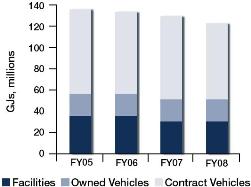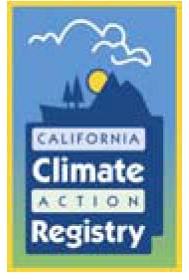Our Environment
The Postal Service has a long record of environmental stewardship, and has integrated sustainability throughout our organization.
Total Energy Use


Alternative fuel vehicles, such as this hybrid electric vehicle from Azure Dynamics Corp., are helping the Postal Service meet its goal of increasing use of non-petroleum fuels by 10 percent by 2015 from a 2005 baseline.
What is a gigajoule (GJ)? A joule is the metric equivalent of the British Thermal Unit (Btu). Both are unit measures of energy, or the amount of force needed to move a given weight. A gigajoule is equal to one billion joules, or the amount of energy required to continuously power one 100 watt light bulb for 115 days.
Nonstop Effort and Improvement
We’ve implemented programs in nearly every operation, including building and equipment design, facility management, fleet operations, waste management, materials sourcing and product stewardship.
Energy management is a key aspect of our sustainability strategy and a driver of economic health. Our efforts make our buildings, equipment and vehicles more efficient and reliable and provide a safe and healthy environment for our employees and customers.
A major challenge facing the Postal Service is reducing energy use without adversely affecting operations ― a delicate balance that requires continual attention. To deliver more than 500 million pieces of mail every day, our sorting machines operate almost continuously and our vehicles are constantly on the road. In fact, our fleet of delivery and collection vehicles travels more than one billion miles each year.
Since energy management affects our workforce, we expect every employee to be involved in our improvements. Our conservation culture encourages employees to consider the energy, environmental, social, and economic impact of their daily activities.
In 2008, our operations consumed about 123 million gigajoules (GJ) of direct and indirect energy. This includes 32.4 million GJ from our facilities and 18.5 million GJ from our owned vehicle fleet. Our contract transportation partners consumed an additional 72.5 million GJ.
FY 2008 marked a decline in our overall energy use due to several factors, including policy changes, a number of conservation projects, awareness programs, getting employees to change energy use habits, as well as an overall reduction in mail volumes and a move toward more efficient modes of transport
Continued investments in environmentally sound processes and technologies will improve our performance over time.
Participation in External Programs
|
As part of our role as a sustainability leader in the mailing industry, we look for opportunities to influence our industry and our partners by participating in voluntary sustainability-related programs. |
|
California Climate Action RegistryCalifornia Climate Action Registry In 2007, the Postal Service became a founding member of the California Climate Action Registry (CCAR), a clearinghouse for organizations to voluntarily register their GHG emissions. As a founding member, the Postal Service has committed to measure, verify and report its GHG emissions annually to the CCAR. We also are members of its sister agency, the Climate Registry. |
 |
EPA WasteWise ProgramFor almost a decade, the Postal Service has been a partner in EPA’s WasteWise Program, which helps USPS reduce the amount of waste we produce. Last year was the ninth straight year that the Postal Service has been recognized as EPA’s WasteWise Partner of the Year. |
 |
Department of Energy Clean Cities ProgramClean Cities is a public-private partnership designed to reduce petroleum use by advancing use of alternative fuels, vehicles and other fuel reduction initiatives. The Postal Service recently worked with Clean Cities, which is sponsored by the Department of Energy’s Vehicle Technologies Program, to determine the best location for more than 5,000 new E-85-capable flex-fuel vehicles. |
 |
International Post Corporation Environmental Measurement and Monitoring SystemThe Postal Service works closely with the IPC, a cooperative association of 24 postal operators in Europe, North America and Asia. In 2008, IPC piloted its Environmental Measurement and Monitoring System, which is intended to gauge the carbon efficiency and management proficiency of member organizations. The Postal Service is an active participant in this program. IPC plans to release initial results of 21 postal operators in late 2009. |
|
|
|
|
